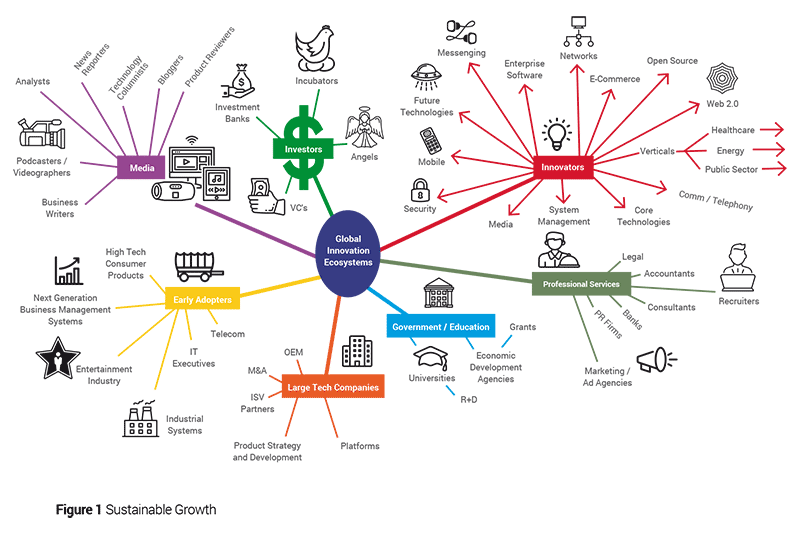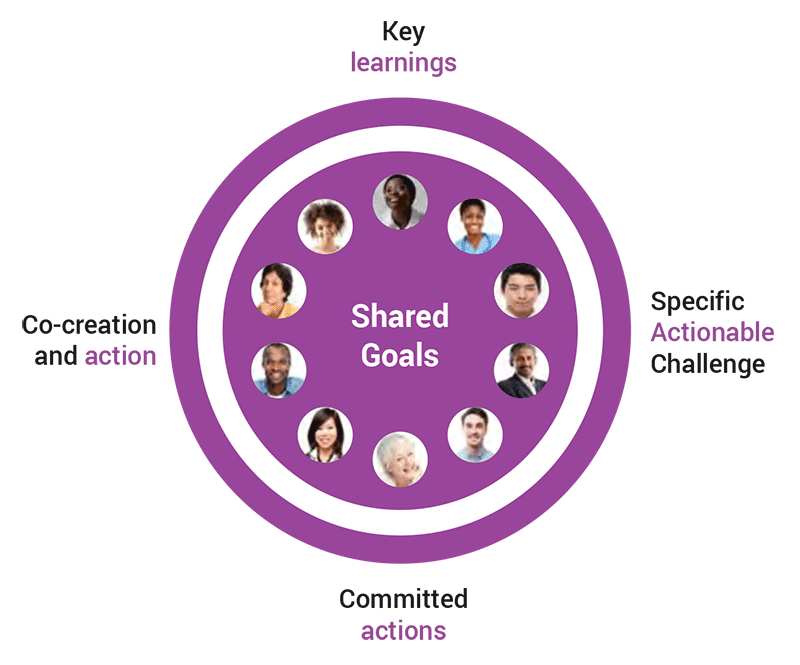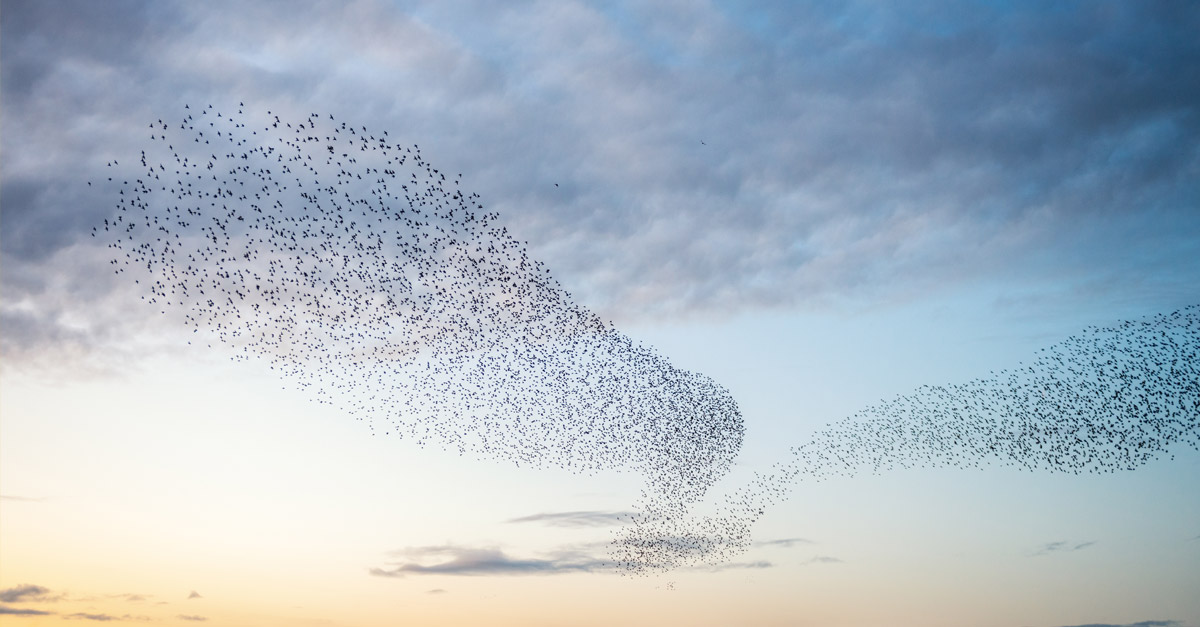For centuries, ‘communities of practice’ (as coined by Etienne Wenger-Trayner and Jean Lave) have been formed to inspire and guide growth for their members. From guilds to farming cooperatives and executive peer groups, the collaborative sharing of ideas and resources has delivered results.
A recent study by the Vistage CEO community showed that CEOs who collaborate with peers achieve 30% greater results than leaders who go it alone.
C.S. Lewis — ‘Two heads are better than one, not because either is infallible, but because they are unlikely to go wrong in the same direction.’
Ecosystems fit into the framework of ‘The Lived Experience’ perfectly, demonstrating that mutualism allows for the social system as a whole to flourish.
In today’s world of ambiguity, accelerated digitalisation, disruption, and everchanging business landscapes, the need for global diverse communities where people can get out of their ‘echo-chamber’, to access and work with people who bring new views to shared challenges is growing. This is leading to Innovation Ecosystems which are an increasing part of the Lived Experience.
Examples of thriving ecosystems throughout time:
- Earth where plants, animals, and other organisms, as well as weather and landscape, work together to form a bubble of life
- Guilds bringing together masons with different skills
- WEF Davos Agenda and the Xynteo Exchange Program in which corporate leaders are advancing
An Innovation Ecosystem is an ‘interconnected system’ or a working group through which individuals with common goals, purpose, or challenges can openly share, collaborate, learn, and co-create new opportunities.
Silicon Valley is the ‘birthplace’ of the global innovation ecosystem collaboration – interconnecting startups, students, investors, corporations, the public sector, and service providers committed to changing the world through technology. It is precisely this incubation of collaboration, fierce competition, agility, continual learning, and moving forward that makes Silicon Valley one of the most successful places for entrepreneurs in the world.
As leaders grapple with the complexities inherent in the Future of Work, traditional ways of gaining inspiration and insight (corporate retreats, innovation courses, conferences) no longer give the multidimensional view needed. In the words of Oystein Bach, Novartis, ‘There isn’t a book or course on post-pandemic growth in the 21st century – we are writing it. By collaborating with others in an Innovation Ecosystem, I gain new perspectives as we co-create the future.’
How and why Innovation Ecosystems work
In an Innovation Ecosystem, 3-20 people from diverse backgrounds collaborate regularly to share experiences, challenge one another, and learn from each other – to advance a common purpose, goal, or challenge. All are committed to taking action, sharing key learnings, and contributing equally to create value for all in the ecosystem.
By supporting and holding one another accountable to get out of the comfort zone and think differently everyone learns, while ‘writing the book’ of success. In addition, there are opportunities for hands-on collaboration to co-create new products, tools, and business models.

Innovation Ecosystems can ‘pop up’ as opportunities arise or be long-term collaborations. The critical success factors for an effective ecosystem are:
- Equal commitment from all participants who are open to new ideas, brave enough to be challenged, and dedicated to showing up, following up, and sharing their learning.
- Diversity – in gender, age, location, industry, but with shared passion or common challenges.
- A facilitator or a catalyst (from within the group or ideally an outside objective party) to ensure equal contributions and accountabilityfor action.
- Confidential environment that allows and encourages all to speak open – ideally on a digital platform that allows human connection globally.
Innovation Ecosystems in Practice
Through work in an Innovation Ecosystem, leaders from Global 2000 companies including Schneider Electric, Novartis, Sutter Health, Burson Cohn and Wolfe, IKEA, RoboBank, Norwegian Air, Hydro, Cap Gemini, YMCA, Wilhelmsen, TechnipFMC, have experienced the power of communities working together.
By participating in bi-monthly (2 hour) facilitated Executive Growth Circles (EGC), the ecosystem members have overcome adversity, co-created new solutions, and delivered record-setting results.
Each Circle is structured around a Specific Actionable Challenge (SAC) relevant to all members. SACs may be as specific as, ‘how do I identify new business partners to advance circularity in my industry’ or as broad as, ‘how do I transform organisational culture to motivate behaviour aligned to the company goals’.
At the beginning of each circle, members share their key learnings from real-world situations, then guided by a Catalyst, they collaborate to identify alternatives to address the challenge. Finally, all leave with Committed Actions to apply insights from the circle in the real world. This often includes collaboration between the ecosystem members as they co-create future opportunities.
During the following circle when the leaders reconnect, they are each accountable for sharing their learnings from taking these actions. As each member of the circle shares their key learnings, all gain deeper insight into ways to approach common challenges. As many community members work on various aspects of a specific challenge such as ‘transforming culture’ across multiple circles, the collective learning grows exponentially. Ultimately members of the circle gain confidence that they have a strong base of experiences on which to make decisions and take future actions.
Unlike casual meetups with colleagues, conferences or courses, Innovation Ecosystems are built on:
-
- Common goal, challenge, or opportunity shared by all members of the ecosystem
- Commitment by all to take actions then openly share learnings and insights from real-world experiences
- Accountability for actions, equal sharing, and value creation for and by all members
- Diversity in perspectives as people from different countries, industries, backgrounds, generations, and roles work together.
- Relevancy of Specific Actionable Challenge for all in the circle.
Results achieved through Innovation Ecosystem:
Some of the Specific Actionable Challenges addressed are described below.

How can I build a culture of innovation and creativity into traditional corporate culture?
Building an innovation culture in which employees are empowered to explore, take quick action, and delight customers are critical to success. However, shifting mindsets and inspiring out-of-the-box creativity in traditional organisations can be difficult.
Through collaboration in the circles, members successfully: Built creativity and innovation into daily activities for all team members even those working remotely; implemented forward-thinking OKRs (Objectives and Key Results) – moving from financial performance driven KPIs and transformed incentive programmes to reflect the connection between the company strategy and employees’ personal goals.
The result? Each company reported increased revenue, faster time to market, and improved employee satisfaction.
Some of the key learnings for the individuals in the circle included:
- Recognition that peoples’ ambitions and ways of living have changed and it is essential to adjust culture to address evolving needs.
- Creating time for team members – asking questions, listening, and helping employees understand how they will benefit from taking on greater responsibility speeds up change.
- Power of aligning incentives with company objectives and individual employee motivations.
- Need to lead by example – personally taking risks, sharing failures and wins.
How do I transform my business model and scale my operations rapidly while maintaining financial health?
Commonly referred to as ‘riding two horses simultaneously’ the challenge of bringing new products, and business models (which may cannibalise traditional offerings) to market is often addressed in EGCs.
Members who worked on this SAC have successfully launched new offerings, while gradually shifting resources from existing offerings – leading to record revenue growth through learning to:
- Set clear goals and openly communicate progress toward each milestone.
- Enable the Try-Fail-Grow approach. Celebrate risk-taking, even when the risk fails.
- Empower autonomous teams to design, develop and launch new solutions – outside of traditional KPIs or reward systems.
- Gain full commitment from, and share progress openly with, all stakeholders.
- Celebrate each win along the way.
How to disrupt instead of being disrupted – co-creating new revenue streams
By sharing diverse perspectives, collaborating around customer journeys, needs, and values, ecosystem members identified, defined, and co-created new cross-industry solutions.
Along the way, they learned:
- The importance of understanding customer motivations (not just behaviour) today and (using predictive AI) the future.
- Ways to align product packaging and pricing with customers’ perception of value.
- Criticality of learning by doing, pivoting, seeking honest feedback from people with diverse views.
Anything is possible when people who bring diverse views to a common goal collaborate in a safe space. This particular SAC led to the launch of a new service co-created by two highly regulated public/private entities – in 9 months (compared to previous 9-year time to market).
Future of Innovation Ecosystems
Accelerating complexity, volatility, digitalisation, and competition require out-of-the-box thinking and a different approach to innovation. Through providing access to diverse perspectives, accountability for action, commitment to address common challenges and create new opportunities, Innovation Ecosystems are a glimpse of what the collaboration model of the future might look like.
As the lines between organisations, customers, and employees become more fluid and the boundaries blur between work and personal life, Innovation Ecosystems have the potential to evolve into a new way of working in the Lived Experience. This is similar to engagement in a Decentralised Autonomous Organisation (DAO). In DAOs, individuals spanning industries and continents commit to working together on a common purpose, creating and sharing value equally. You can learn more about DAOs in ‘The DAO of Work’ by Diana Wu David in this supplement.
Closing
We are all writing the book of future success through lived experience. The good news is that you don’t have to do it alone. Innovation Ecosystems provide support and inspiration within a community of fellow explorers who share common goals and challenges. If you want to learn more about working in or building an innovation ecosystem, please get in touch with the author.
The Lived Experience, Working Life in the 21st Century:
This is one of a series of 13 practical articles on leadership written by the Future Work Forum (FWF) for the European Foundation for Management Development (EFMD), an accreditation body for business schools globally with a membership of 30,000 management professionals. Our partners have contributed to a special edition of their Global Focus magazine.

About the Future Work Forum:
The FWF exists to explore the working world of tomorrow. It is a think tank and network of highly skilled experts who share a passion to create a better, more humanised workplace, inspiring a new generation of leaders.


